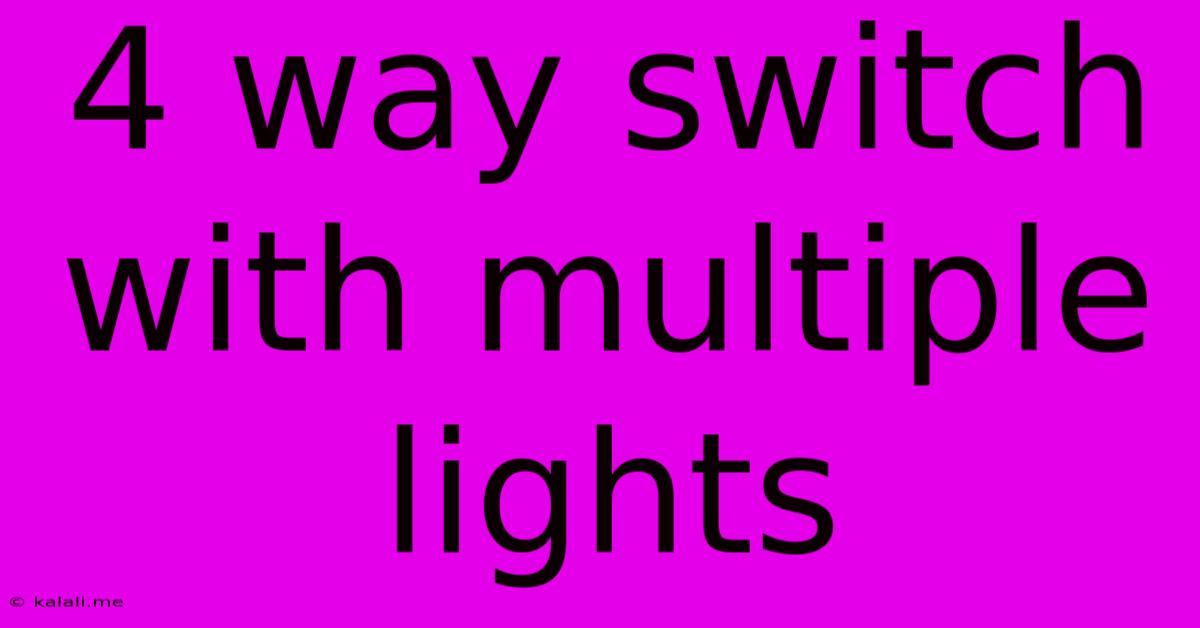4 Way Switch With Multiple Lights
Kalali
Jun 02, 2025 · 4 min read

Table of Contents
Controlling Multiple Lights with a 4-Way Switch: A Comprehensive Guide
Are you tired of flipping multiple light switches to illuminate a single room or hallway? A 4-way switch system offers a sophisticated solution for controlling multiple lights from different locations, enhancing convenience and home automation. This guide will explain how a 4-way switch system works, its applications, and the steps involved in its installation.
This article covers the functionality and installation of a 4-way switching system, ideal for controlling multiple lights from three or more locations. We'll explore the wiring diagrams, safety precautions, and troubleshooting tips for a successful setup. Understanding the mechanics of this setup improves home lighting control significantly.
How a 4-Way Switch System Works
Unlike a standard single-pole switch, which controls a light from one location, a 4-way switch system requires at least three switches: two 3-way switches and one 4-way switch (or more 4-way switches if controlling from more locations). This setup allows you to turn lights on or off from any of the switch locations.
- 3-Way Switches: These switches have three terminals, enabling the control of a light from two different locations. They're crucial components in a multi-location lighting system.
- 4-Way Switches: The 4-way switch acts as an intermediary, allowing the signal to pass through from one 3-way switch to another, effectively controlling the circuit from multiple points. It has four terminals to facilitate this signal transfer.
The system relies on the interaction between the switches to control the power flow to the light fixture. The lights only turn on when the switches are configured in a specific combination. This combination is determined by the switch positions and how they interact within the circuit.
Common Applications of 4-Way Switch Systems
4-way switches are exceptionally useful in various home settings, increasing control and efficiency of lighting systems:
- Long hallways: Control lights from both ends of a long hallway.
- Staircases: Turn lights on and off from both the top and bottom of the stairs for safety and convenience.
- Large rooms with multiple entrances: Manage lighting from different entrances within a large space.
- Outdoor lighting: Control landscape lighting from multiple locations in your yard.
Installing a 4-Way Switch System: A Step-by-Step Guide
Disclaimer: Electrical work can be dangerous. If you are not comfortable working with electricity, consult a qualified electrician. Always turn off the power at the breaker box before starting any electrical work.
Materials Needed:
- Two 3-Way Switches
- One 4-Way Switch (or more, depending on your setup)
- Electrical wire (appropriate gauge)
- Wire connectors
- Electrical tape
- Voltage tester
- Screwdriver
Steps:
- Turn off the power: Locate the breaker controlling the light circuit and switch it off. Verify the power is off using a voltage tester.
- Remove existing switches: Remove the existing switches and carefully note how the wires are connected. Take pictures if necessary.
- Wire the switches: This is the most crucial step and requires careful attention to the wiring diagram. Consult a wiring diagram specific to your setup for detailed instructions. Common configurations involve connecting the common wires to one side of the switches, and travelers to the remaining terminals.
- Connect the wires: Securely connect all wires using wire connectors and electrical tape. Ensure all connections are tight and secure to avoid loose connections and potential hazards.
- Test the system: Turn the power back on at the breaker box and test the switches from all locations. The lights should turn on and off from each switch.
- Troubleshooting: If the lights don't function correctly, double-check all wire connections. Ensure the power is off before troubleshooting any wiring issues.
Troubleshooting Common Issues
- Lights don't turn on: Check all wire connections, the circuit breaker, and the bulbs themselves.
- Switch doesn't work from one location: Check the wiring at that specific switch and ensure proper connections.
- Flickering lights: This may indicate a loose wire or faulty switch. Inspect the wiring and replace any faulty components.
Implementing a 4-way switch system significantly enhances home lighting control. By understanding the system's mechanics and following the proper installation procedures, you can enjoy a more convenient and efficient lighting solution. Remember, safety is paramount. If you're unsure about any step, consult a qualified electrician.
Latest Posts
Latest Posts
-
I M Getting Permission Denied On My Bash Script
Jun 03, 2025
-
Do You Capitalize Happy New Year
Jun 03, 2025
-
What Subject For Email Asking Someone To Talk To You
Jun 03, 2025
-
Cumulative Link Mixed Models R Threshold Coefficients
Jun 03, 2025
-
How To See Durability On Items In Mc
Jun 03, 2025
Related Post
Thank you for visiting our website which covers about 4 Way Switch With Multiple Lights . We hope the information provided has been useful to you. Feel free to contact us if you have any questions or need further assistance. See you next time and don't miss to bookmark.